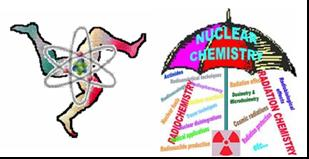Speaker
Dr
Richard Lindstrom
(National Institute of Standards and Technology)
Description
Accurate nuclear measurements depend on well-controlled experimental and numerical work, both in the execution of daily measurements and in the creation and evaluation of fundamental constants needed to connect the laboratory with the International System of Units. It cannot always be assumed that tabulated data are sufficiently accurate for all routine work. The k0 Nuclear Data Committee has identified a number of radionuclides whose half-lives are not adequately known for accurate neutron activation analysis, as judged by disagreements between published evaluations. We have applied gamma-ray spectrometry and least-squares methods developed for other nuclides to redetermine the decay constants of 90mY and 97Ru. Irradiated samples of each pure element were counted continually through several half-lives, acquiring up to 100 spectra with good statistics. Photopeaks from each nuclide were evaluated with a fixed-boundary integration routine, and each resulting data point corrected for rate-related losses before fitting to an exponential function by a nonlinear least-squares procedure. Preliminary values are 3.205 ± 0.005 h for 90mY and 2.84 ± 0.01 d for 97Ru, where the uncertainty is the standard deviation of the mean of several determinations. Although by chi-squared criteria the fits to the decay curves were very good and the uncertainty of the resulting half-lives an order of magnitude smaller than the published discrepancy, care is necessary before assigning a best value with a totally defensible uncertainty to the overall data set.
Author
Dr
Richard Lindstrom
(National Institute of Standards and Technology)
